Are you one of those people who are passionate about cooking? Are you ready to share your mind-blowing recipes with the rest of the world?
Well, you’ve come to the right place. Because today, we’ll be discussing how to create a food blog that lets you share your creations with the world.
You may have this question in mind: Is it hard to start a food blog? Well, with the right approach, you can get started quite easily.
Here are 9 actionable steps to create a wonderful food blog:
- Choose an ideal niche for your food blog
- Select a catchy name for the blog
- Opt for a suitable domain and hosting provider
- Set up on the right blogging platform
- Design your blog that captivates your audience
- Invest in high-quality food photography
- Plan an SEO-friendly content strategy
- Promote your blog by leveraging social media platforms
- Monetize your blog with your preferred method
Do you want to listen to a podcast explaining each of these strategies in detail?
Then hit the play button below!
Also, I will go through each of these steps in detail in the following sections in this article, so that you can get started with a successful food blog without a hassle!
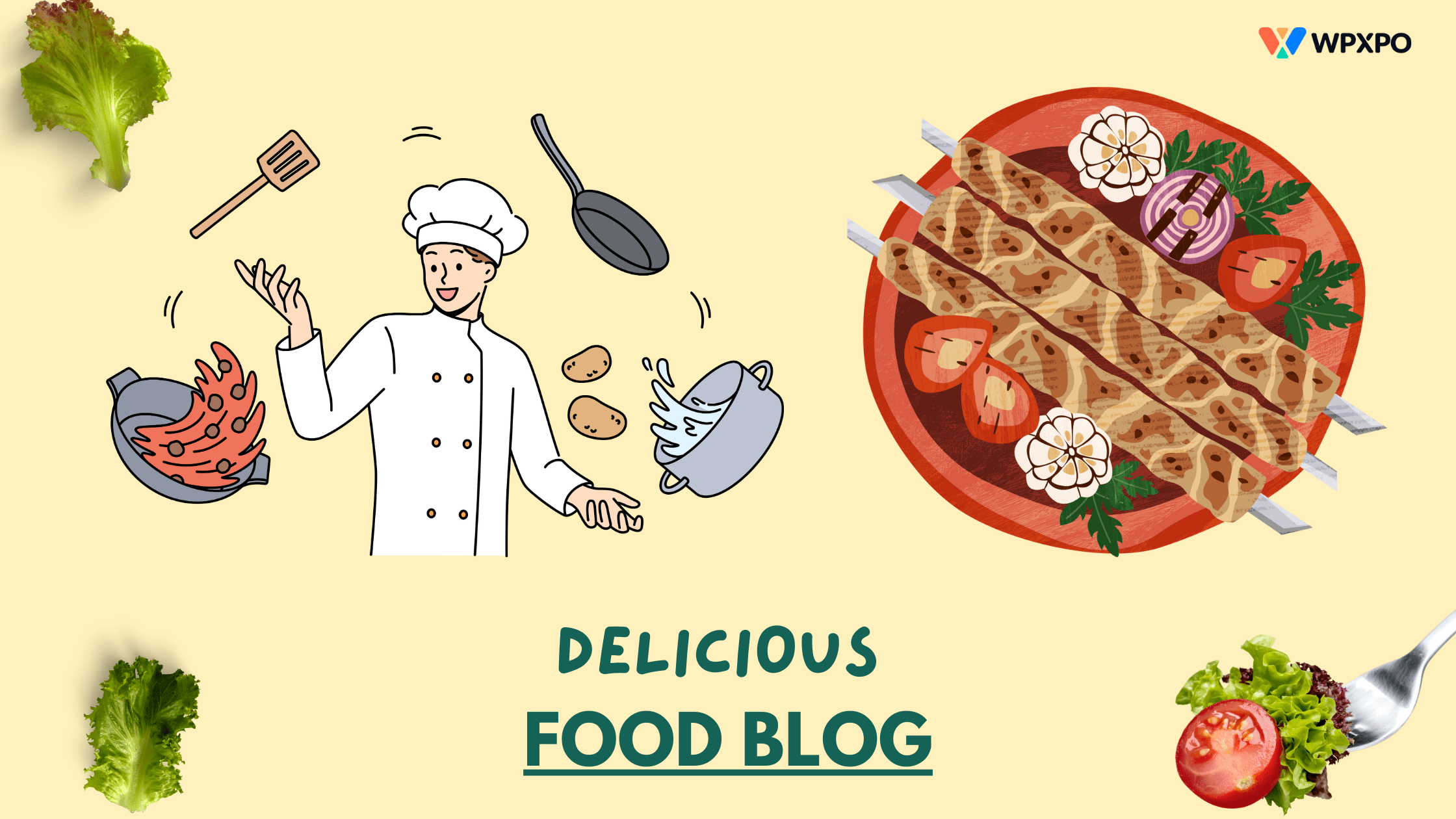
How to Start a Food Blog: Detailed Steps
In the following sections, I will discuss details about each of the important steps you must take to build a successful food blog and start making money. Note that, it is comprehensive content, so if you need to prepare, why not grab a cup of coffee and start reading? 😉
1. Choose a Niche for Your Food Blog
You need to be super careful in this first part. This is where people make mistakes.
In many cases, bloggers tend to shoot for the stars, meaning they go for a broad competition. And that’s something you may want to avoid at the very beginning. Because building authority [we will be discussing that in a later part] for a broader niche will be hard.
Also, select something you are highly passionate about. If you don’t do so, you may end up losing up to the competition.
What you want to do is narrow down your competition. In other words, you should choose a particular niche to show off your expertise. Every 60 seconds, more than 170 websites are going live. So, you may have to do some pre-digging before starting off with the rest of the process.
If you want, you can read the following blog on niche validation and research. It’s an excellent piece written by John Rampton. You can find it in the resources section at the very end.
What Are the Key Food Blog Types?
Finding the right niche for your blog is tough if you’re just starting out. If that’s the case, then you may want to look at the various food blog types that are on the web. This can help generate ideas:
- Diet blogs (for example Keto, DASH, Paleo, WW, and more).
- Vegetarian blogs (Pescetarians, Pollotarians, lacto-vegetarians, and more.)
- Recipe Blogs ( quick recipes, easy recipes, recipes for workaholics, and more.)
- Region-specific cuisines ( Greek, Asian, Italian, French, Indian, Thai, Chinese, and more.)
- Cookbooks
- Food, travel, and photography.
If you’re just starting out, then you should do some more digging (maybe some soul-searching as well). Maybe you can come up with your own niche (who knows!). Just make sure to find one that suits you and your style of cooking.
You may want to take some inspiration from the top food bloggers in the industry. We have a resource for you to check out somewhere at the end.
2. Choose A Catchy Name for Your Blog
A great blog name has the power to positively impact your brand identity and attract your target audience. Here are some tips to help you choose a proper name for your food blog:
- A Sweet and Punchy Name that matches your goal
- Relevant to your style of cooking
- Keep it short
- Focus on something easy to remember
Just to mention, these are also the considerations you should keep in mind when choosing the domain name for your blog.
If you want some helpful examples for naming your food blog, here are some suggestions to get you started:
Keyword-Based Names:
- Example: “The Vegan Kitchen,” “Gluten-Free Gourmet”
Descriptive Names:
- Example: “Flavorful Fridays,” “Sunday Supper”
Playful Names:
- Example: “Foodie Finds,” “Kitchen Calamities”
Personal Brand Names:
- Example: “Sarah’s Savory Secrets,” “David’s Delicious Dishes
Choose the naming style you want to apply. Do you want to set the name to be playful or do you want it to reflect your personal brand? Either way, choose a name that best reflects your goal and the type of food blog you want to create.
If you still need help brainstorming name ideas, you can use tools like Namelix to generate cool names for your blog.
3. Select Suitable Domain & Hosting Providers
The next important thing to do before starting a blog is choosing the right domain and hosting providers.
Before starting with what we recommend, let’s start with what we DON’T Recommend:
Evaluating Free Hosting
It’s basically the answer to the question: ‘How to create a food blog for free?’
With free hosting, you do not have to invest in anything. You can pretty much start with $0 and start your website. Sites like WordPress.com, and others are decent choices in this case.
The above-mentioned choices are all great. And you can probably create great blogs on your own with these platforms without any specialized help. Cool!
Unfortunately, with free platforms, your options are very limited. Your hands will be tied down in terms of customization. As a matter of fact, you will not be able to create a food blog that matches your style. And there’s the fact that you may be pelted with ads on some free platforms, urging you to upgrade.
So, while free options might seem tempting to use, if you are serious about blogging, you will need proper solutions. In the next two sections, I will tell you how to choose the right domain for your blog and introduce you to some popular options.
i. Choosing the Right Domain for Your Blog
A domain name is your website’s address on the internet. When choosing a domain name provider, you want to ensure reliability, ease of use, and good customer support.
Popular Domain Providers
Here are some popular domain name providers:
GoDaddy:
- One of the largest domain registrars.
- Offers a wide range of domain extensions and additional services like website building and hosting.
Namecheap:
- Known for its affordable prices and user-friendly interface.
- Offers a variety of domain extensions and additional services.
Tips for Choosing a Domain Name Provider
- Reliability: Choose a provider with a strong track record of reliability and uptime.
- Customer Support: Good customer support can be invaluable, especially when you encounter issues.
- Ease of Use: A user-friendly interface can make managing your domain easier.
- Security: Look for providers that offer strong security measures to protect your domain.
- Additional Services: Some providers offer additional services like website hosting, email, and SSL certificates.
ii. Choosing Hosting Providers for Your Blog
When choosing a hosting provider for your food blog, it’s essential to consider factors like reliability, performance, security, and cost. Here’s a brief overview of the popular hosting providers you can choose from:
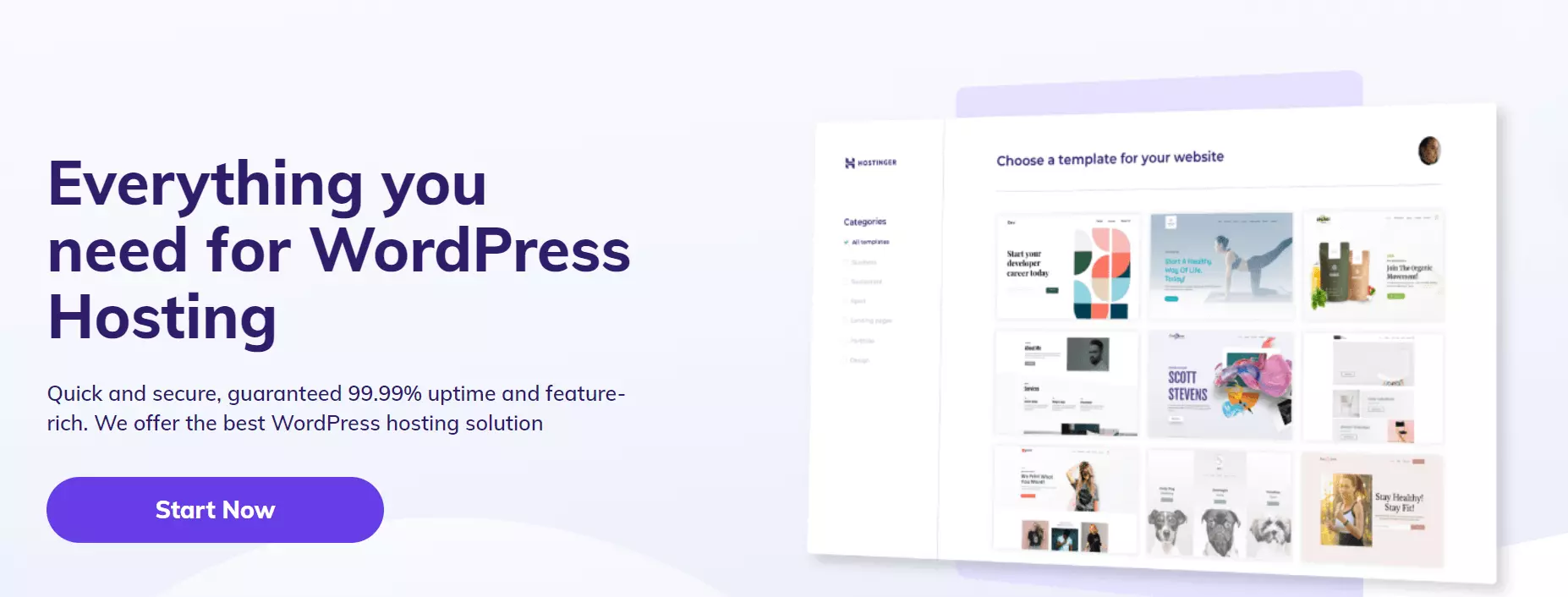
Hostinger
Hostinger is a budget-friendly option that offers decent performance and features. It’s a good choice for those who are just starting out and have a limited budget.
SiteGround
Known for its excellent performance and customer support, SiteGround is a top choice for many bloggers. It offers a user-friendly interface, fast loading speeds, and robust security features.
Bluehost
Recommended by WordPress itself, Bluehost is a reliable and affordable option. It provides easy-to-use tools for beginners and offers various plans to suit different needs.
DreamHost
DreamHost is a popular choice among developers and offers a variety of plans, including managed WordPress hosting. It’s known for its reliability and excellent customer support.
HostGator
HostGator is a well-established hosting provider that offers a range of plans, including shared, VPS, and dedicated hosting. It’s known for its easy-to-use control panel and reliable performance.
When choosing a hosting provider, you should consider these factors:
- Uptime: Look for a provider with a high uptime guarantee to ensure your website is always accessible.
- Speed: A fast-loading website is crucial for user experience and SEO.
- Security: Choose a provider that offers robust security features to protect your website from potential issues.
- Scalability: As your blog grows, you may need to upgrade your hosting plan. Choose a provider that offers scalable solutions.
- Customer Support: Good customer support can be invaluable when you encounter technical issues.
- Cost: Consider your budget and choose a plan that fits your needs.
By following these factors, you can choose the best hosting provider for your food blog and ensure its success.
4. Choose a Suitable Blogging Platform
A blogging platform is an online software or service that allows users to create, publish, and manage blog posts and content. These platforms provide tools to design, format, and organize blog entries without needing extensive technical knowledge
Here are a few of the most popular blogging platforms:
WordPress.org:
- Highly customizable and offers a wide range of themes and plugins.
- Requires self-hosting and technical knowledge.
- Ideal for those who want full control over their website.
WordPress.com:
- Easier to use than WordPress.org, but offers less customization.
- Suitable for beginners who want a simple and hassle-free solution.
Blogger
- A free platform offered by Google.
- Easy to use but limited in terms of customization and advanced features.
- Good for those who want to start blogging quickly and easily.
Wix:
- A drag-and-drop website builder that allows you to create a beautiful website without coding.
- Offers a wide range of templates and customization options.
Squarespace:
- Known for its sleek and modern designs.
- Offers a user-friendly interface and a variety of templates.
Factors to Consider When Choosing a Blogging Platform
- Ease of Use: Consider your technical skills and the level of complexity you’re comfortable with.
- Customization: If you want full control over your website’s design and functionality, WordPress.org is a great option.
- Cost: Some platforms are free, while others require a monthly or annual fee.
- SEO: Choose a platform that is SEO-friendly and allows you to optimize your content for search engines.
- Support: Good customer support can be invaluable, especially if you encounter technical issues.
For a food blog, WordPress.org is often the preferred choice. It offers the flexibility to create a unique and engaging website, and there are many WordPress themes and plugins specifically designed for food blogs.
Why WordPress?
Over 40% of all the websites in the world are powered by WordPress. And that’s not all, it powers almost 15% of all the top websites in the world. Moreover, at the time of creating this content, more than 500 websites are being built on the WordPress platform.
The reason for these heavy stats is the usability of WordPress. You can easily create, curate, edit, and manage your website with this CMS (Content Management System). No other CMS can offer such flexibility of use as of now.
How to Install WordPress to Launch Your WordPress Food Blog
If you have purchased and set up your domain and hosting providers, you can easily get started with setting up a WordPress.org site. Simply follow these steps:
- Install WordPress: Most hosting providers offer a 1-click WordPress installation via their control panel. Follow their instructions to set up your WordPress instance.
- Connect Domain to Hosting: Update your domain’s DNS settings to point to your hosting provider’s nameservers (found in your hosting account).
- Log in and Customize: Log in to WordPress (usually
yourdomain.com/wp-admin), then select a theme and install plugins as needed to customize your site. - Publish Content: Start adding pages and posts to build out your website.
These steps should get you started and you can easily manage and customize your WordPress site!
5. Present Your Food Blog with Captivating Design
As you’re moving to create a unique WordPress food blog, you’ll need to focus on designing your website. Creating a food blog requires you to choose your own brand colors, use the right theme, and design the blog in such a way making it easier for the reader to interact with the content on your blog.
You can choose brand colors [check out the resources section at the very end] and use them across the food blog in a meaningful. Since we are using WordPress, there are two ways we can go about it:
- Using A Food Blog Theme
- Using A Gutenberg Builder Plugin
Choosing the Right Food Blog Theme
Finding the right theme for your food blog can be tricky sometimes. But you can easily search with terms like “Food Blog” and get relevant themes. Check out reputable directories like WordPress.org, aThemes, ThemeForest, and TemplateMonster to explore hundreds of suitable options.
Also, here are a few tips to help you decide the right theme:
- Feature Set: Confirm that the theme offers features that matter to you, like visual customization, accessibility, and responsive design.
- Visual Appeal: Check theme previews to see if they suit your aesthetic.
- Ratings and Reviews: Pay attention to feedback regarding compatibility and support.
After you have selected your preferred theme, here are quick steps to install it in WordPress:
- Navigate to Appearance > Themes from your dashboard.
- Search for the theme by name or click Add New to upload one you’ve already downloaded.
- Once found, simply Install and Activate the theme.
After you have set up the theme, you can do further customization to give your blog the look you want.
Choosing a Gutenberg Builder Plugin
A Gutenberg builder plugin can make all the difference when it comes to designing a visually captivating and well-organized food blog.
One of the leading plugins in the industry is PostX which enhances the Gutenberg editor with specialized blocks and premade templates.
Instead of manually building complex website layouts, PostX offers ready-made solutions that save time and ensure a polished look for your blog.
Here’s how it can help you design a beautiful food blog:
Starter Sites for Quick Design
PostX includes Starter Sites templates tailored to different types of blogs. For food bloggers, there are specific layouts designed for showcasing recipes and culinary stories. These templates are fully customizable, letting you design a complete website in minutes!
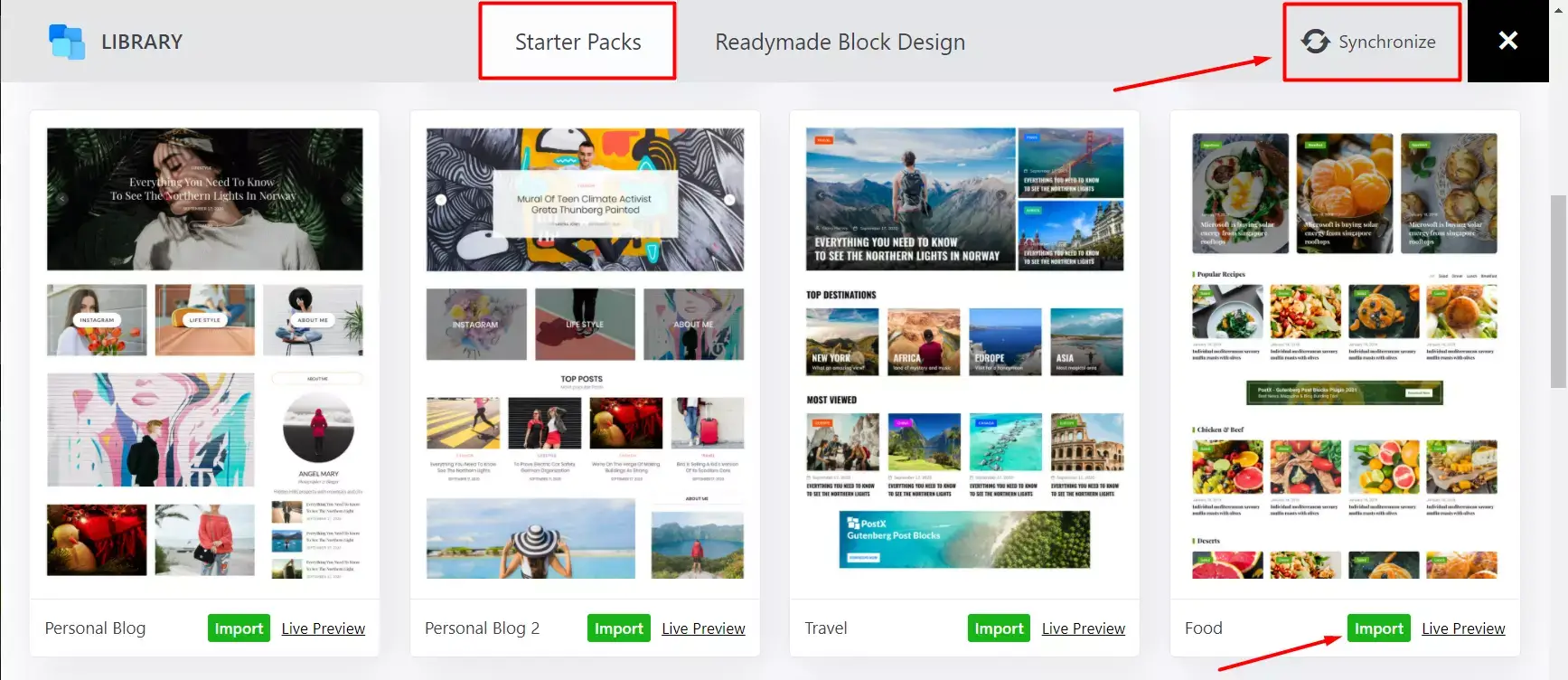
Each starter pack comes with a carefully arranged block layout, from featured recipes to categorized recipe lists, so you can captivate readers without extensive design work.
Dynamic Post Slider
One of the highlights of PostX is its Dynamic Post Slider block, perfect for showcasing featured recipes or popular posts at the top of your food blog.
The slider offers several customization options, letting you adjust image size, text overlay, call-to-action buttons, and many other options.
It’s a great way to visually engage readers as soon as they land on your page.
Advanced Query Builder
Food blogs often have a range of posts, from recipes to restaurant reviews, and the Advanced Query Builder allows you to filter and display posts based on categories, tags, dates, or even custom taxonomies.
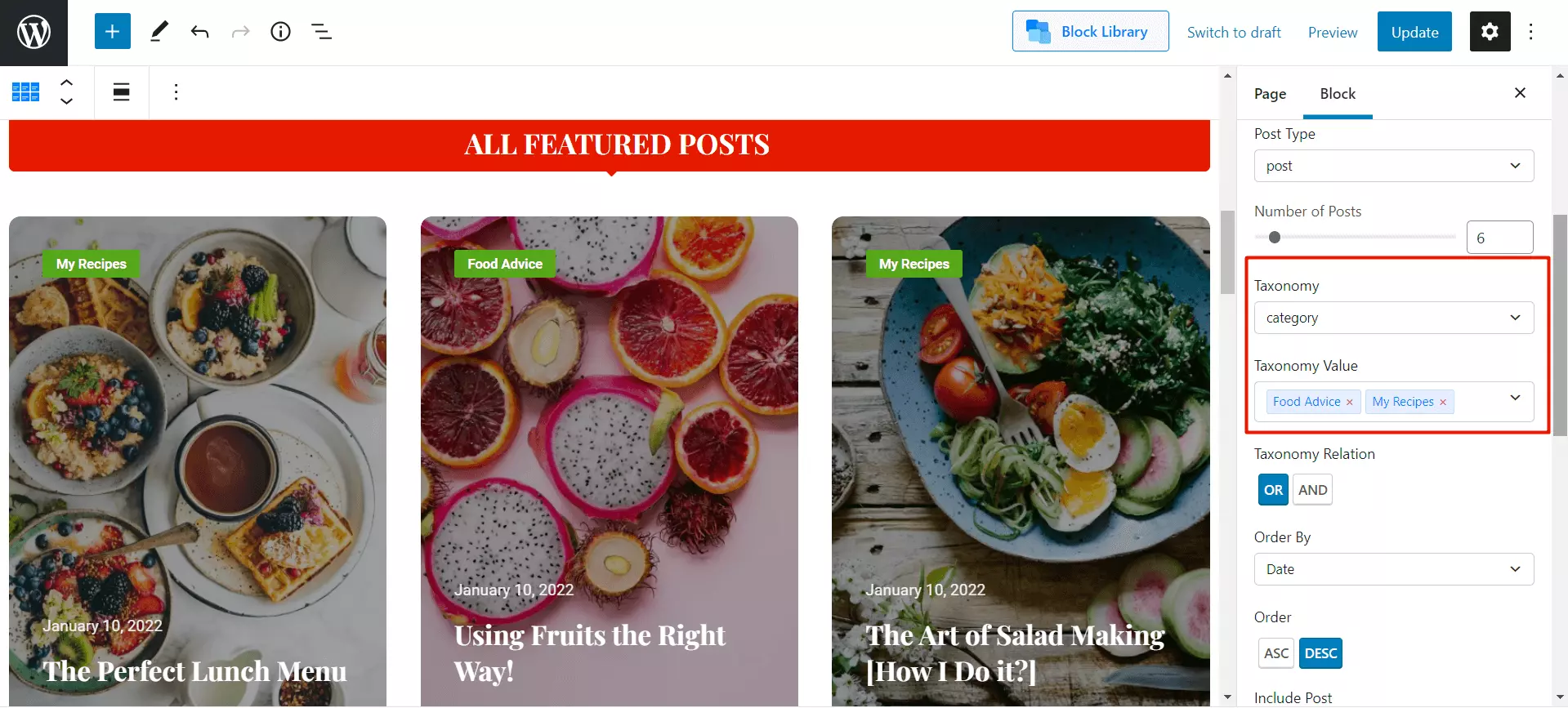
This feature is very effective for:
- Displaying seasonal recipes or trending topics.
- Highlighting top-rated or most-commented posts.
- Creating dedicated sections for categories like “Healthy Recipes,” “Desserts,” or “Quick Meals.”
AJAX Filtering and Pagination
For food blogs, with a wide range of recipes, AJAX-powered Filtering and Pagination can ensure smooth browsing. Readers can instantly filter content by category or tag without reloading the page.
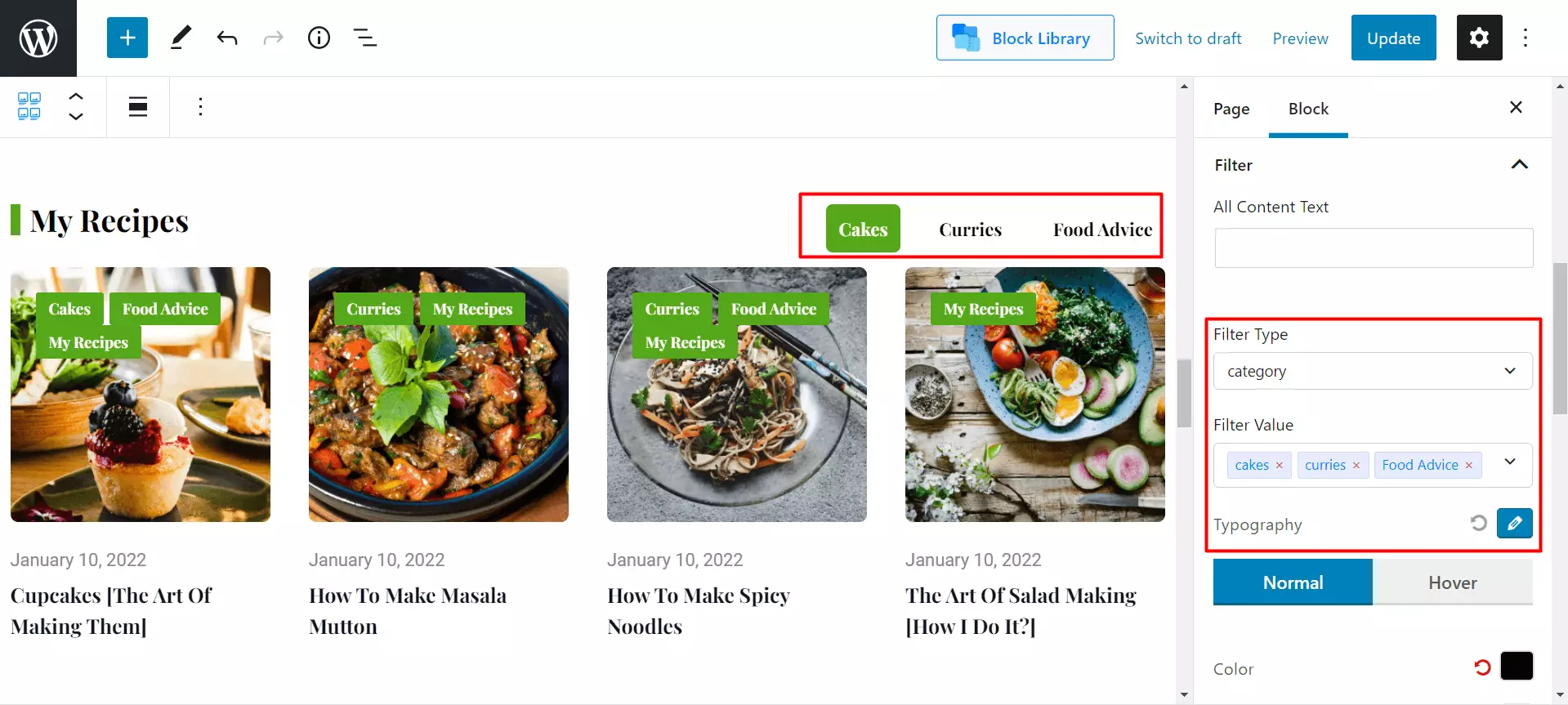
PostX offers this user-friendly feature making it easier to find relevant recipes – leading to improved user engagement.
Saved Templates for Reusability
PostX also includes a Saved Templates feature, allowing you to create custom layouts and reuse them across different posts.
For example, you can design a standardized recipe card that includes an image, ingredients list, cooking steps, and a call-to-action button for sharing on social media.
Using the saved template, you can quickly insert this design into any post, maintaining consistency and saving time.
Overall, with the help of PostX, you can design your food blog to not just perform well but also look beautiful and attract readers.
6. Invest in High-Quality Food Photography
In food blogging, high-quality visuals are essential. Mouth-watering images can captivate readers, keep them on the page longer, and make them more likely to try your recipes. Here’s how to add amazing pictures of your foods for maximum impact:
Use Natural Lighting: Natural light enhances the textures and colors of food, making it look fresh and appetizing. Place your setup near a window for the best results, or use soft diffusers to avoid harsh shadows.
Experiment with Angles: Certain dishes look better from specific angles. For example, overhead shots are ideal for flat dishes like salads or pizza, while side angles work better for layered desserts or stacked foods.
Use High-Resolution Images: Ensure images are sharp and clear, even after compression. High-resolution images make your blog look professional and encourage readers to stay and explore more.
Optimize for Speed: High-resolution images should be compressed to maintain quality while reducing load time. Tools like TinyPNG can reduce file sizes by up to 30–35%, improving site speed and user experience.
Investing time in quality photography helps you stand out in a crowded market. When images are visually stunning, they encourage readers to engage and share your content.
7. Prepare for Content SEO on Your Food Blog
Search Engine Optimization (SEO) is crucial for driving organic traffic to your food blog. Crafting SEO-friendly content helps your recipes rank higher in search engine results, making it easier for readers to find and follow your cooking journey.
Here’s a detailed guide to setting up strong SEO practices for your food blog.
Focus on Customer-Centric Content
The core of SEO is user experience. Make sure your content addresses the needs and questions of your audience. When writing recipes or food-related posts, think about what users want to see:
Recipe Details: Include prep time, cooking time, serving size, and variations to make it easier for readers to follow along.
Helpful Context: Add background stories, cooking tips, or insights that make the recipe engaging.
Problem-Solving Approach: Anticipate reader questions and incorporate answers within the content, such as ingredient substitutions or storage instructions.
Keyword Research for Food Blogs
Effective keyword research connects your content to popular search terms. Here’s how to approach it:
Identify Seed Keywords: Start with a general keyword, like “vegan chocolate cake,” then explore variations.
Use Long-Tail Keywords: Long-tail keywords like “easy vegan chocolate cake with coconut oil” may have less competition and attract more specific search intent, increasing the likelihood of reaching interested readers.
Analyze Search Intent: Understand why users search for a term and tailor your content to match that intent. For example, a search for “quick vegan dinner ideas” signals users want fast, easy recipes.
Use tools like Ahrefs, Semrush, and Google Keyword Planner to uncover related keywords, their search volume, and competitiveness. Aim to include your primary keywords naturally within your content and subheadings.
Leverage On-Page SEO Techniques
Use an on-page SEO checklist to make sure each element of your post is optimized:
Internal Linking: Link to related posts within your blog to guide readers to similar recipes and improve site navigation. This also helps search engines understand the relationship between your posts.
Alt Text for Images: Add descriptive alt text for each image. Include relevant keywords naturally, like “sliced fresh avocado on toast” for better image search optimization.
SEO Title and Meta Description: Create a compelling SEO title and meta description that incorporate keywords and encourage clicks from search engine results.
URL Structure: Keep URLs short, descriptive, and aligned with your primary keyword.
Prioritize User Value Above All
Above all, your content should be valuable and enjoyable to read. Readers will return to blogs that help them find what they need quickly and effectively:
Avoid Keyword Stuffing: Instead, prioritize clear, engaging writing.
Provide Unique Value: Add value by offering unique cooking techniques, tips, or personal stories.
Optimize Readability: Write in short paragraphs, use bullet points, and break down recipes step-by-step to make your blog user-friendly.
By following these SEO best practices, your food blog is more likely to rank well in search results, making it easier for people to find and engage with your delicious content.
Here are some useful resources to get you started with your content SEO:
1. How to Perform Search Engine Optimization for Content.
2. How to Perform On-page Search Engine Optimization
8. Promote Your Food Blog
Congratulations on setting up your food blog! Now comes the vital next step: getting readers. Promoting your blog helps people discover and enjoy your content, so let’s dive into effective strategies to attract an audience.
Develop Authority in Your Niche
Establishing yourself as a trusted source is essential for a successful food blog. Here’s how:
- Offer Authentic Content: Share unique recipes, cooking techniques, and food reviews based on your own experience. Highlight tips that come from personal testing, and cite trusted sources.
- Maintain Consistency: Be regular with your posts and keep your tone, branding, and quality steady. Over time, this builds trust and helps create a loyal reader base.
Leverage Social Media
Social media is a powerful tool for food bloggers. It offers access to huge audiences across various platforms:
- Choose the Right Platforms: Focus on Instagram and Pinterest for visually-driven content. These platforms are ideal for food imagery and recipes.
- Engage with Users: Build rapport with your followers by responding to comments, creating polls, or sharing behind-the-scenes content.
- Use Stories and Live Sessions: Facebook Stories, Instagram Stories, and Facebook Live are highly engaging and encourage interaction. They help you connect more personally with your audience.
Collaborate with Other Food Bloggers
Collaborating with other bloggers can maximize your blog’s reach. Partner with food bloggers who have established audiences and you can arrange collaboration opportunities:
- Share Content Together: Host live cook-offs or recipe swaps, then post the collaboration across both your platforms.
- Learn from Peers: Observe what popular food bloggers are doing to improve your approach and make connections.
Create and Share Video Content
Video content is one of the most effective ways to promote your food blog. Use YouTube, Instagram Reels, and Facebook to post engaging videos:
- Share Short Recipes or Tips: Video recipes and quick kitchen tips are popular and easy to consume.
- Tell a Story: Develop a storyline to keep viewers engaged, such as a “day in the life of a food blogger” or “behind-the-scenes” of creating a recipe.
- Collaborate: Feature other food bloggers or chefs to add credibility and variety to your content.
9. Monetize Your Food Blog
So far, you’ve created a wonderful-looking food recipe blog, done social media research and planning, created useful content, done some search engine optimization. In every possible way, your blog is ready to get you some benefits.
Now the question is how to create a food blog website that sells.
Here are some things you can do:
Use Google ads for Monetization
You can gain a generous reward for your efforts through Google Ads. But, you may want to create a proper blog first before jumping into the whole process.
Nonetheless, it can be a great source of revenue.
Leverage Email Marketing Strategies
Email marketing is another way of letting your fans know of your food creations. It’s one of the best ways to reach out to your audience with the latest and greatest resources from your food recipe blog.
Make sure to invest some time into a proper email marketing strategy. It will certainly help you out on your journey.
Explore Affiliate Marketing Opportunities
Another opportunity you can explore is affiliate marketing. This is of course a lengthy process and demands a time frame of its own.
So, if you wish to involve yourself in affiliate marketing, you may want to consider doing some research. Here is a useful resource you can explore: How to start your affiliate marketing journey?
Other Important Resources
We have other useful resources for you to explore:
- How to choose a niche for your food blog in 5-steps
- Inspiring food bloggers: How they manage it?
- How to Choose a Domain Name?
- How to choose brand colors for your food blog?
FAQ
Here are answers to some frequently asked questions.
How do food bloggers get paid?
Food bloggers can explore a lot of monetization opportunities like Google ads, creating and selling ebooks, email marketing, and more. However, all these ventures require a good deal of planning. If you want to get paid as a food blogger, then make sure to be ready to commit to the whole journey.
How do I become a food blogger?
Your passion for cooking will decide whether or not you’re suited for food blogging. If you really think you can offer something super useful, make a plan, do your research, understand your users, and, on top of all, create awesome recipe content for your audience.
Do recipe blogs make money?
Recipe blogs do make money via mediums like ebook sales, ads sales, and more. However, it can be difficult without proper niche targeting, authority building, and search engine optimization.
What should I write in my food blog?
A food blog should be about a specific niche or cuisine-related recipes, helpful tips on cooking, cooking queries, and more. And that’s where you need to know how to create a food blog that appeals to your audience.
How many recipes do I need to start a food blog?
In general, you should target at least 10-20 unique recipes to start your food blog. Also, you will need cooking queries and recipe-related tips as well to capture the attention of your audience.
Final Thoughts
If you’ve made it this far, congratulations! You now know how to create a food blog in WordPress. You also know how to create a food recipe content that sells.
Yes, it’s been a long journey. Still, our purpose was to create a piece of content that will get you up and running on your food blogging journey. We’re confident that you’ll get good guidance to start your journey into creating recipes for the masses.
Make sure to sound off in the comments below. Also, you may want to share useful insights with us.
Cheers!
Get PostX Pro to unlock all exciting features and make amazing Websites
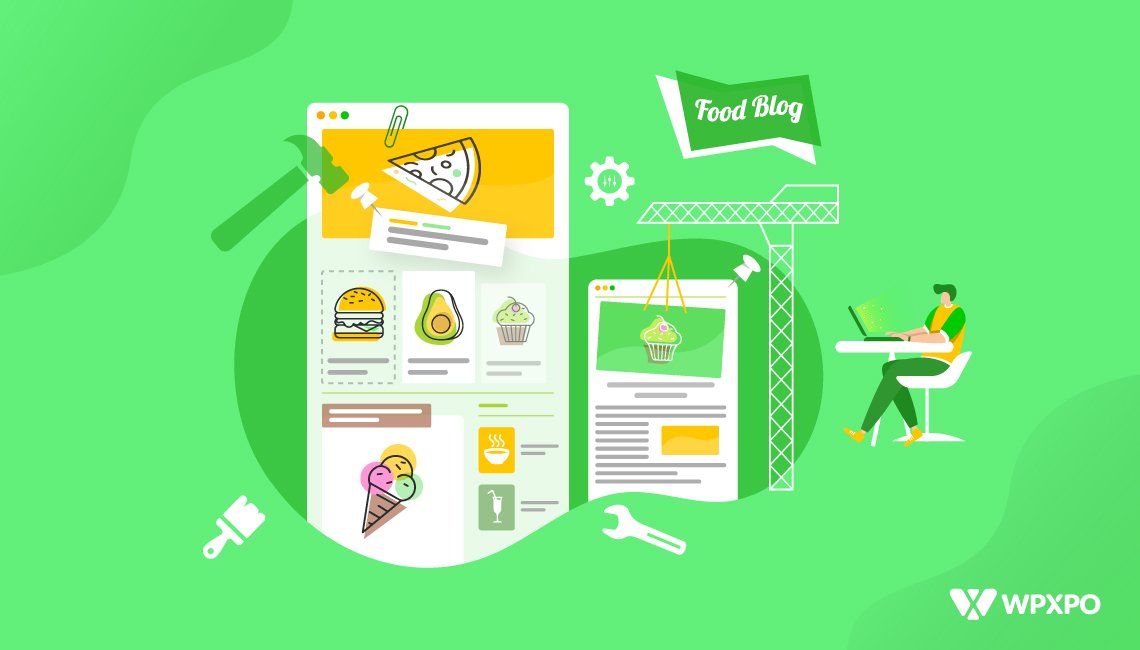

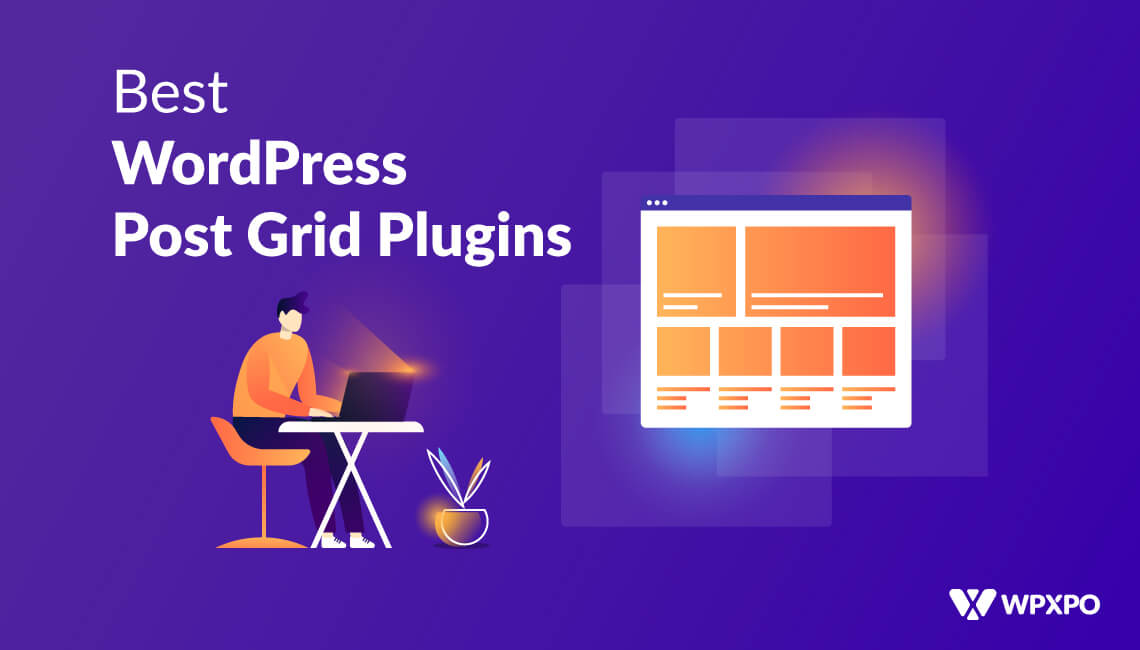
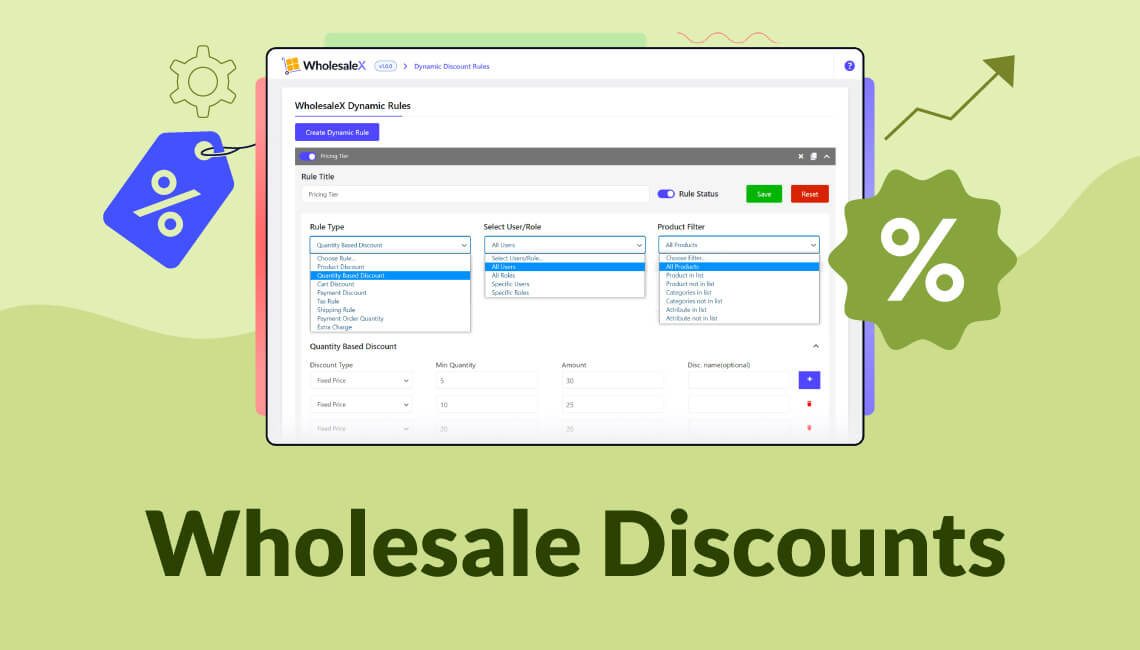
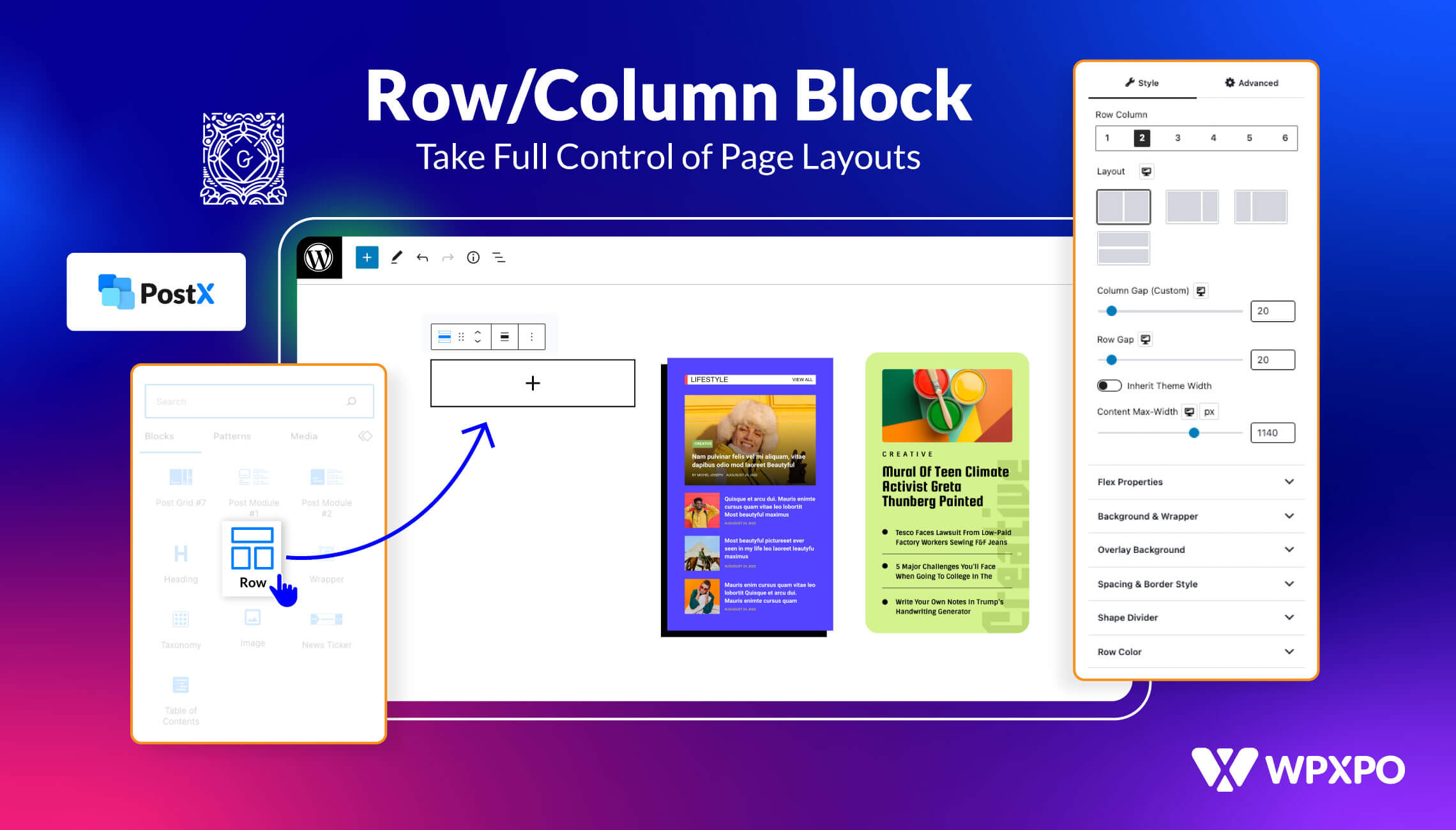
Technologies
February 17, 2024Thank you for sharing this very important information. We find it useful on Surewebdesigner.com